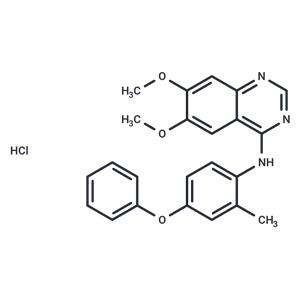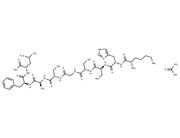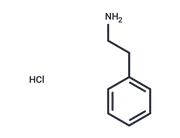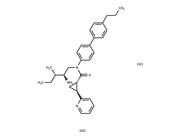| Name | APS-2-79 hydrochloride |
| Description | APS-2-79 hydrochloride (APS-2-79 HCl) is a MAPK antagonist that modulating KSR-dependent MAPK signalling by antagonizing RAF heterodimerization as well as the conformational changes required for phosphorylation and activation of KSR-bound MEK. |
| Cell Research | Cell viability assays are performed in 96 well plates. Optimal cell densities for 96 well plate assays are determined to obtain linear growth over the timecourse of assays. Specifically, A549, HCT-116, A375, SK-MEL-239, COLO-205, LOVO, SK-MEL-2, CALU-6, MEWO, SW620 and SW1417 cells are plated at 500 cells per well and treated with inhibitors for 72hrs before measuring viability. H2087 and HEPG2 cells are plated at 2000 cells per well, and treated with inhibitors for 72hrs. Cell viability is measured using resazurin, and the percent cell viability is determined by normalizing inhibitor-treated samples to DMSO controls(Only for Reference) |
| Kinase Assay | JNK phosphorylation: 500,000 cells/well are seeded in 6-well plates and incubated overnight. Cells are then incubated for 1 h with test compounds or DMSO as vehicle control (?nal concentration 1% v/v). Puromycin is added (?nal concentration of 18 μM) and cells incubated for a further 10 min to label nascent polypeptide chains. Background labelling is determined by incubating cells without puromycin. Cells are then washed in HBSS, harvested by scraping and centrifuged (300 g, 5 min). Cells are resuspended in 0.5 mL 50 mM DTT containing phosphatase inhibitors and incubated at 95℃ for 10 min. Samples are then snap frozen in liquid nitrogen and stored at -20℃ until blotted. Samples (20–30 μg protein/sample) are blotted onto a PVDF membrane. The membrane is blocked and incubated with anti-phospho-Thr183/Tyr185-JNK antibody overnight at 4℃. Secondary antibodies are used to label the primary antibody and detected using an infrared scanner. The intensity of the ?uorescence signal for anti-phospho-JNK antibody is background corrected and normalized for loading. |
| In vitro | APS-2-79 functions as an antagonist of MEK phosphorylation by RAF through direct binding of the KSR active site. APS-2-79 is inactive when KSR was absent or when the KSR2(A690F) mutant was used for in vitro assays. APS-2-79 increases the potency of several MEK inhibitors specifically within Ras-mutant cell lines by antagonizing release of negative feedback signalling[1]. |
| Storage | Powder: -20°C for 3 years | In solvent: -80°C for 1 year | Shipping with blue ice/Shipping at ambient temperature. |
| Solubility Information | H2O : < 1 mg/mL (insoluble or slightly soluble)
DMSO : 90 mg/mL (212.32 mM), Sonication is recommended.
Ethanol : 30 mg/mL (70.77 mM), Sonication is recommended.
|
| Keywords | Mitogen-activated protein kinase kinase | MEK | MAPKK | MAP2K | KSR2 | APS-2-79 Hydrochloride | APS279 hydrochloride | APS 2 79 hydrochloride |
| Inhibitors Related | CMPD1 | Vemurafenib | Lidocaine | SKLB-163 | sodium lauroyl-α-hydroxyethyl sulfonate | Lidocaine hydrochloride | Takinib | NG25 | PD 198306 | Honokiol | Pelitinib | Trametinib |
| Related Compound Libraries | Anti-Colorectal Cancer Compound Library | Osteogenesis Compound Library | Pain-Related Compound Library | Bioactive Compound Library | HIF-1 Signaling Pathway Compound Library | Kinase Inhibitor Library | Anti-Obesity Compound Library | Inhibitor Library | NO PAINS Compound Library | Immunology/Inflammation Compound Library | Bioactive Compounds Library Max | Anti-Liver Cancer Compound Library |

 United States
United States






